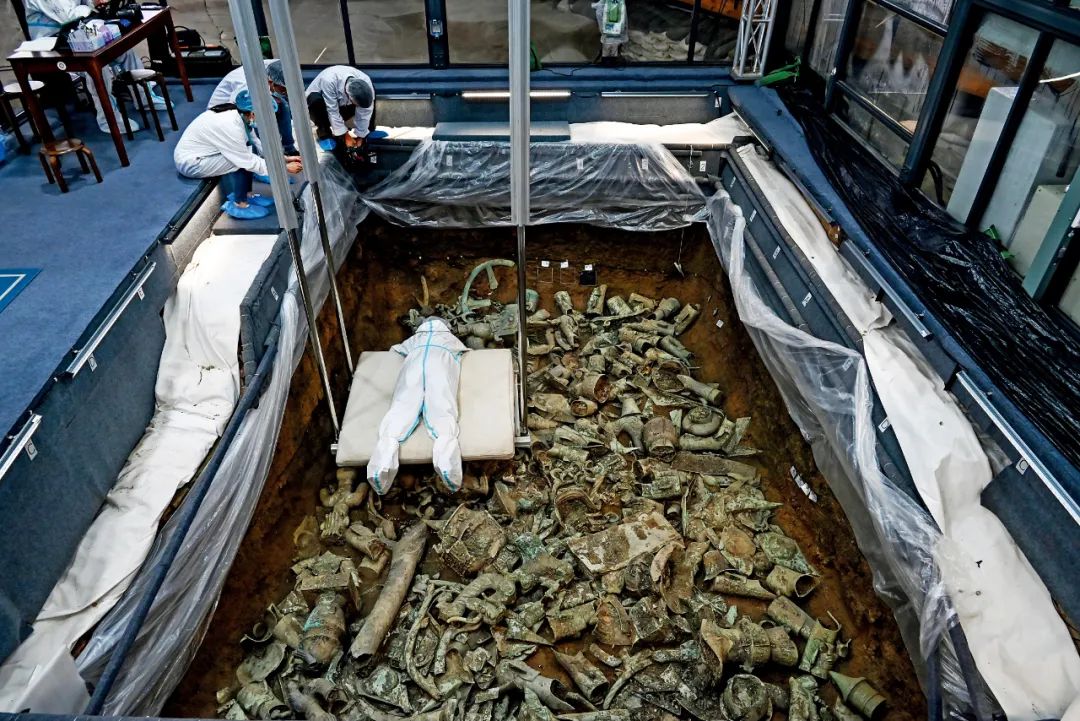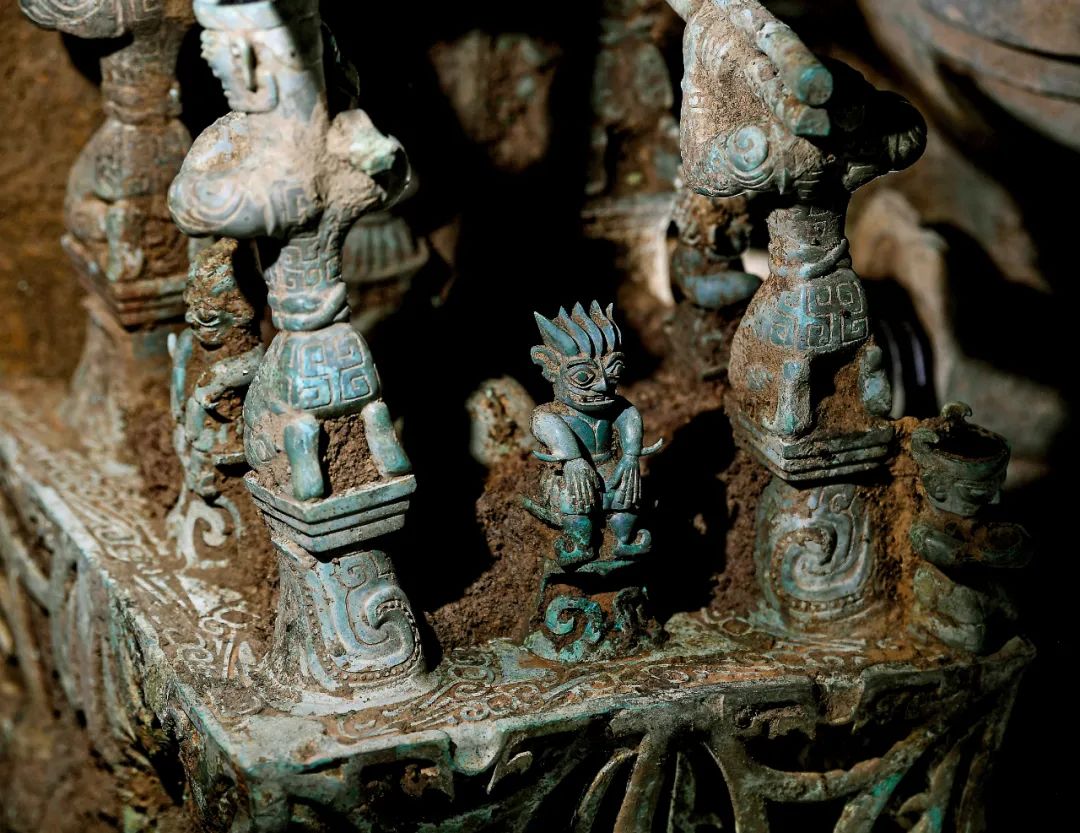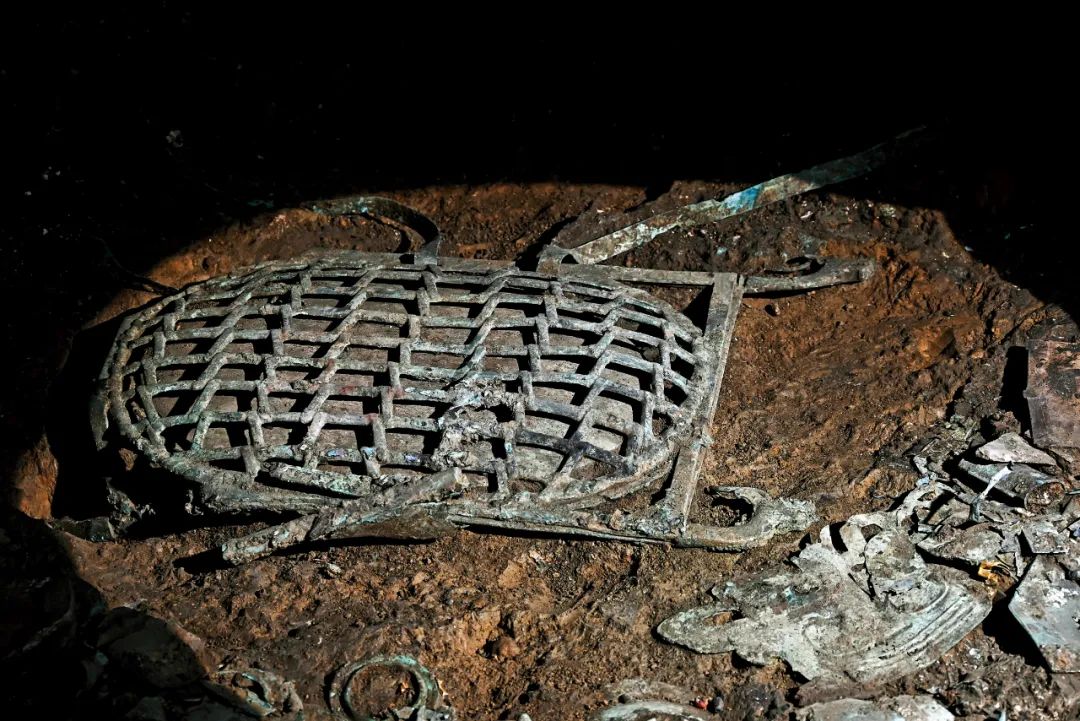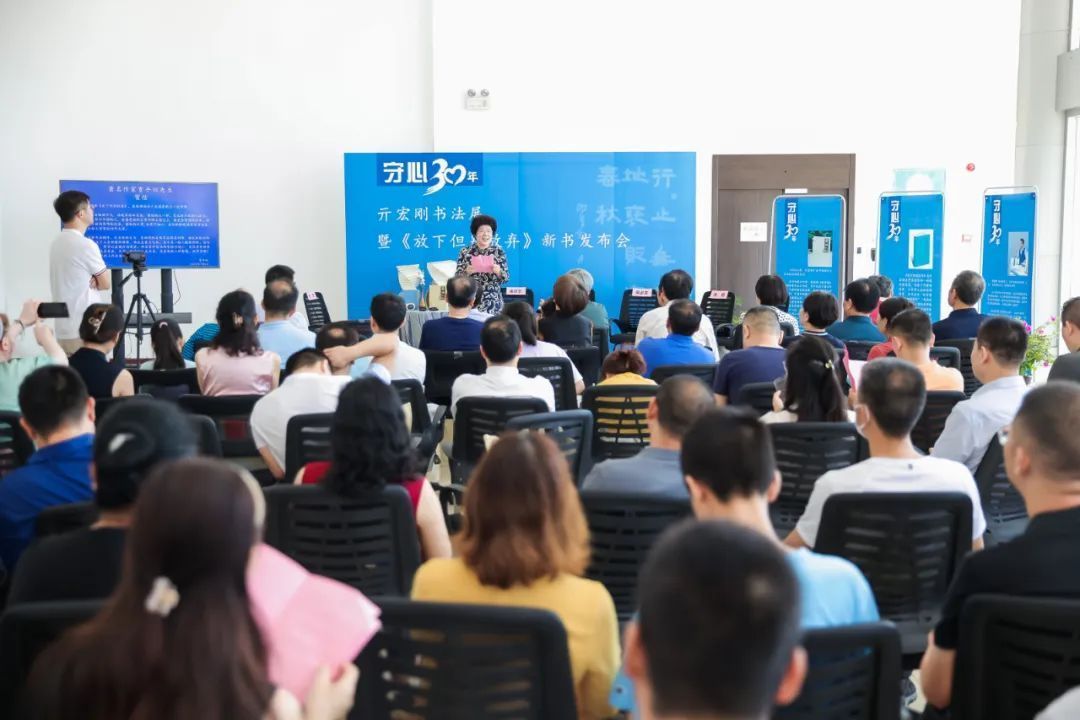Why is it so difficult to test the age for Sanxingdui?
Author:China News Weekly Time:2022.07.01

not
After testing the annual samples of nearly 200 Sanxingdui "sacrifice pits"
It is found that it is equivalent to the late Shang Dynasty in the Central Plains
About 3200 to 3000 years ago
This result has solved the past 30 years
Controversy about the "sacrifice pit" buried era
Since Samsung Dou launched the system archeological excavation again in 2020, the phased results have been announced several times, and the newly discovered cultural relics such as gold masks and bronze masks have gradually appeared. On June 13 this year, the Sichuan Provincial Institute of Cultural Relics and Archeology again released new results in Guanghan, announcing that nearly 13,000 cultural relics have been excavated among six utensils.
Another less notable new achievement has a breakthrough significance.
After the Sichuan Archaeological Institute announced that after the annual year measurement of nearly 200 samples, it was found that the annual data concentration was concentrated from 1131 to 1012 BC, equivalent to the late Shang Dynasty in the Central Plains, about 3200 to 3,000 today. The hospital stated that the result resolved a dispute over the years of the "sacrifice pit" in the past 30 years.
About a series of mysteries of Sanxingdui is one of the core areas. From the perspective of archeologists, the age and nature have always been the key to answering the ultimate question of Sanxingdui culture.
Due to the lack of technical means during excavations in the 1980s, the problem of the age did not get a more accurate answer. For example, Zhu Naicheng, a researcher at the Institute of Archeology of the Chinese Academy of Social Sciences, said in an article, "For a long time, when the academic circles have formed when the Sanxingdui civilization is formed and when the end of the Sanxingdui civilization is completed, how long the entire Sanxingdui civilization has continued, etc. Haven't conducted in -depth exploration yet. "
In 2020, it was repeatedly excavated by six utensils buried with cultural relics. The utensil pit was the most watched part of the Sanxingdui site, but not all. However, the era of utensil pit was determined, and it took an important step for the study of the entire Sanxingdui site and even the Sanxingdui culture.

On June 1, at the archeological site of the Sanxingdui site in Guanghan City, Sichuan, the staff was cleaning up the No. 8 "sacrifice pit". Figure/IC
How to measure the year for Sanxingdui
The key contribution to the year of Sanxingdui utensils is carbon fourteen technology.
The institution responsible for this test is the "Archaeological Joint Laboratory" jointly formed by the Archaeological Research Center of the State Administration of Cultural Relics and the Peking University Archaeological Expo College. The United Laboratory is located in an old house with a gray -tile white wall at Peking University. It was just established in March this year. In fact, the carbon fourteen test year at Peking University has a history of nearly 50 years. There are two most well -known carbon fourteen -testing laboratories in the field of Chinese archeology, and the other belongs to the Archaeological Institute of the Academy of Social Sciences.
Archaeological projects across the country must be sent to one of these two institutions if they need to be tested in the 14th of the 14th. According to previous reports, Peking University's fourteen samples to be tested each year are 2,000 or three thousand.
There were more than 200 carbon fourteen samples before and after the Sanxingdui. Wu Xiaohong, a professor at the Peking University Archaeological Board Institute and Director of the Joint Laboratory of Archeology, wrote that at least 6 reliable carbon in the fourteen pits of the six pits of the six pits was generated in the annual test. First select 10 samples in each pit and send them to the laboratory for pre -treatment: Plant debris should be treated with acid -base acid to eliminate carbon pollution in the environment; in addition to the treatment of acid -base acid, bone slag samples, in addition to the treatment of acid -base acid, the treatment of acid and alkali acidic acid, in addition to the treatment of acid -base acid, the treatment of acid and alkali acidic acid, in addition to the treatment of acid and alkali acidic acid, the treatment of acid and alkali acidic acid is treated. It is also necessary to extract collagen, and further hydrolyze, centrifugal, frozen and dry, and prepare glue protein.
In this process, many samples were eliminated one after another because of poor storage conditions. In this way, new samples need to be supplemented, so the total amount of samples reaches more than 200 copies. The preservation of samples on the fifth pit and No. 7 pits is not good, and there are less than 6 samples that eventually produce reliable data.
Perhaps it was a sacrifice ceremony, maybe buried waste, or it may be burned out. Wu Xiaohong said that after the fire was burned, there were three forms of form. The most suitable state of the year was: the plants were dehydrated at a high temperature in the middle of the combustion. Most of these tangible plant debris are relatively tight and dense. It preserves the original carbon content of the plant. After later treatment, it can effectively exclude the pollution brought in the buried environment, which is conducive to the accurate annual year.
Animal bones are usually good carbon fourteen samples, because collagen in the bones is basically non -environmental carbon pollution. However, the bones that are basically not seen in the pit of Sanxingdui utensils are bone residue, and the collagen is mostly degraded. It is likely that it is because the burning is not sufficient, and it is eroded by the humid and humid climate and acid soil. Wu Xiaohong said that the 38 carbon fourteen data of the four buried pits currently obtained are all from plant carbon dandruff and cannot be successfully extracted from the bone slag sample.

The copper god altar unearthed from the 8th "sacrifice pit". Picture/Xinhua
Carbon fourteen is a radioactin of carbon, which was first discovered in 1940. Because the half -life of the carbon 14 is more than 5,000 years and exists in organic objects, it can be inferred that its age can be inferred according to the remaining carbon components of the biological body, as long as it does not exceed 50,000 years.
In 1949, the University of Chicago Professor Wiratoh Libi invented the Carbon Fourteenth Performance Method and won the Nobel Prize in Chemistry 11 years later. In 1965, the Atomic Expert Expert of the Institute of Archeology, the Institute of Institute of Physics of the Chinese Academy of Sciences, and Cai Lianzhen couples established the first carbon fourteen laboratory in China through independent research and development equipment. The laboratory of Peking University was established in 1973. The carbon fourteen testing technology is like a ruler that extends to ancient times, and naturally has obtained the widest application in archeology and geology. Before the carbon fourteen technology testing year, through strata science and type, experts can determine the scope of fuzzy times for the site, but it can only be qualitative and cannot be quantitatively learned about the specific year data. For example, scholars can judge that this ancient tomb was Pei Ligang culture in the Neolithic era. The site site was from Yangshao culture, but we did not know that it was 5000 years, 6000 years, or 7000 years.
Qiu Shihua once said that before the application of the carbon fourteenth year, "the pre -history school was almost completely based on subjective speculation or inference." In the 1990s, on the basis of more than 2,000 carbon fourteen annual data data, it was only established to establish a framework for prehistoric archeology in the late history of the old stone artifacts since the late period.
In 1986, Samsung Dou No. 1 and 2 pits were found under a brick factory, and the unearthed utensils made it "awaken the world." During the excavation, there was no special extraction of the sample for the annual test. But it was just a sporadic detection of some samples.
At that time, the results of the age were not settled. Regarding the age of Sanxingdui, there have been no stopups. Various claims have emerged endlessly. Most of the claims tend to put Sanxingdui early to the early days of Shang Dynasty -that is, before the first time of bronze civilization in China, it seems that it came out of thin air. of.
This unprooped conjecture, conforming to the trend of "myth" into "mythology". "Based on this, there are various imaginative claims, such as the bronze civilization of Sanxingdui is‘ outer passengers ’.” Wu Xiaohong said. In fact, these speculations come from the folk, and there have been no such inferences in the academic world.
The reason is that the annual annual data measurement data is not produced. At that time, the conventional carbon fourteen annual annual method was adopted, and the amount of samples required was very large. After the fire and plant in the two utensils were burned, the unit was stored poorly, and it was difficult to extract a sufficient amount of pure unit scores. So that the two sets of data errors obtained in the end are very large, and the scope of 95.4 % of confidence is as large as 500 to 600 years. In the eyes of archeologists, it is not enough for detailed discussions. The lack of reliability of the absolute age data of the No. 2 Pit is supported by the absolute age, which leaves room for extensive controversy.
Opportunities came after more than 30 years. In 2019, archeologists at Sanxingdui workstation built the edge of the earth and stones at the No. 1 and 2 pits, and found the corner similar to the buried pit. Immediately, the six sacrifice pits saw the day, and the field excavation was launched the following year. This time, archeologists systematically collected carbon fourteen samples. And these six pits are sandwiched between the first and second pits. The eight pits seem to be closely related, and maybe they can understand their age at the same time.
Today, the domestic carbon fourteenth annual measurement technology is very different from that year. Wu Xiaohong told "China News Weekly" that Peking University is equipped with accelerator mass spectrometry instruments, making measuring small carbon fourteen samples possible. It can measure 1 mg of carbon samples, which is thousands of years smaller than conventional carbon fourteen annual measures. Note. For the carbonized plant debris of Sanxingdui, the accelerator mass spectrometry technology came in handy.
The results showed that in the formation of the three, four, six, and 8 pits of the 14th data of the 14th year of carbon, the probability of 95.4 % was between 1200 and 1010 BC. On this conclusion, Wu Xiaohong concluded in the article: "There is no suspense in the late Shang Dynasty in the late Shang Dynasty. If you ask if you can say that you can enter the beginning of the week, from the perspective of the data distribution of the age, this is possible. Yes, it is just such a low probability. "
What mysteries can be solved in the annual measurement
Although the age has been determined, the dispute has not yet subsided. There are too many questions about Sanxingdui, and the problems that can be cleared on this excavation and research are also very limited. Borrowing the archeologist Xu Hong's words, archeological work always "never knows more than knowing". For example, these pits that are metapments as "blind boxes" have not yet formed consensus.
Regarding the nature of eight pits, there are currently two main views, one is the "buried pit" caused by accidental events, and the other is a "sacrifice pit" built many times. "Burning Pit" means that these pits are formed at one time. Archaeologists who support this view speculate that the ancient country of Samsung Deda has encountered major or even catastrophic changes, so that a large number of exquisite utensils that have been destroyed are buried. What changes? There are "war theory", "coup theory", and "temple fire saying" and so on.
Turtle -shaped grid unearthed from "Sacrifice Pit" No. 7. Figure/IC

And if it is a "sacrifice pit", it means that the buried utensils are more daily and ritual, and they are gradually buried for a long time. For some experts who held this view, including the excavation of some experts from the Sichuan Cultural Relics and Archeology Research Institute, the official archeological report published in 1999 was named "Sanxingdui Sacrifice Pit".
Ran Honglin, the director of the Samsung Dedu Archeology Institute of Sichuan Provincial Institute of Archeology, mentioned the "sacrifice pit" in the thesis, and also had to explain: "This article follows the name of the" sacrifice pit "used in the past, but does not mean that we agree The nature of K1 and K2 is a sacrifice pit. On the contrary, we think that the two are not sacrifice pits. "This means that there are different opinions within the Sichuan Archaeological Institute. Regarding the two different views of the pits, when understanding some of the unsolved mysteries of Sanxingdui, different conclusions may be directed.
Sun Hua, a professor at the Peking University Archaeological Board College of Peking University, who has long studied Sanxingdui, believes that Sanxingdui utensil pit is a "buried pit". He interpreted to the media that the results of the annual test fell between about 1100 and 1050 BC. Formation may be related to the disputes within the then Sanxingdui kingdom. Perhaps in terms of choosing goodwill objects, some nobles agreed with merchants, and some nobles advocated supporting Zhou people. Different political claims plus other factors, which led to the turmoil of the Sanxingdui country.
The experts who agree with the view of the "sacrifice pit" believe that Sanxingdui, as the national nature of the sacrifice center, has led to excessive human material resources concentration and social wealth consumption. About the later period of the Shang Dynasty, the ancient kingdom of Samsung Deda gradually lost control, and eventually had severe survival disasters and social panic.
So, can the result of this year -long annual measurement of the fourteenth year be resolved about the nature of the pits of utensils?
Wu Xiaohong, the person in charge of the annual work, pointed out that the formation of several buried pits found in Sanxingdui was roughly comparable. There is no way to get more fine age data. Under such circumstances, it is not beneficial to compare the morning and evening relationship between each buried pit from the perspective of carbon 14 of the data.
Through this annual measurement, it is impossible to judge whether these utensils are buried at a time or in an orderly batch burial, thereby solving the nature of the pits of utensils. Moreover, the conclusion of this annual measurement is generally close to the judgment of previous theater and type learning.
The conclusion given by the archaeological report "Sanxingdui Sacrifice Pit" in 1999 is that the buried time of the No. 1 sacrifice pits should be within the end of Yinxu Phase I and the second phase of the second phase; Between the fourth phase. Yinxu is the late capital city, which means that the ducts of Sanxingdui utensils are in line with the late Shang Dynasty.
Prior to this, the experts were associated with the correlation with the cultural relics of the Central Plains through the Sanxingdui utensils, inferring that Sanxingdui had inextricable connections with the Xiashang era in the Central Plains.
There are some typical clues, such as the respect of the bronze figures, the tooth in the hand, and the image of a large number of dragons, which shows the profound penetration of the Central Plains culture to the southwest. Copper, copper, and bronzes unearthed from Sanxingdui are typical bronze wares of the Central Plains Yin Shang culture. The jade is from Qijia culture in the Ganqing area. It is found that a large number of gold wares are used in line with the traditional gold wares that have been used in the middle of the moon.
"It can be said that the ancient Shu people and the Central Plains region have a considerable degree in the core values or cognitive system," said Lei Yue, the head of the Sanxingdui Site Work Station of the Sichuan Provincial Cultural Relics and Archeology Research Institute. ) Direct rule, but it should have been a big family in terms of cultural identity. "
In the age of exploring the Sanxingdui culture, it was not enough to study the eight pits found in the sacrifice area. These pits can only represent the later period of Sanxingdui civilization. The early cultural relics of Sanxingdui, including Rensheng Village Cemetery on the west side of the Sanxingdui site, the second phase of the city wall of the Sanxingdui Dacheng, as well as the Yuyan Pit of the Yanjiayuan of the Moon Bay Essence Zhu Naicheng, a researcher at the Institute of Archeology of the Chinese Academy of Social Sciences, was that the age of Sanxingdui civilization began between 1600 and 1500 BC, and the end of the end was about 500 years around 1050 BC.
"I think the problem of Sanxingdui needs to be slowly, and the whole excavation and research work is just the beginning." An expert who had deeply participated in the archeological work of Sanxingdui said that there were differences in all aspects of Sanxingdui's age, source, and important buildings. Big, there are many phenomena that are very important. To study a little bit, don't rush to make conclusions. "
Send 2022.7.4 Total Issue 1050 "China News Weekly" magazine
Magazine Title: Sanxingdui test age
Reporter: [email protected])
Edit: Yang Shizhen
- END -
Thirty years of perseverance -Xun Honggang's calligraphy exhibition and "let go but don't give up" new book conference was held in Wuhan

30 years of perseverance -书 Honggang Calligraphy ExhibitionAnd Let go but don't g...
Strait (Zhangzhou) Tea Club Live and Paper Competition Starting
(Reporter Chen Huihui) On June 27th, the eighth Strait (Zhangzhou) tea party Charming on the Cloud Tea Fragrance Zhangxian Charm live broadcast competition was launched. Vice Mayor Lan Wanan and Wan